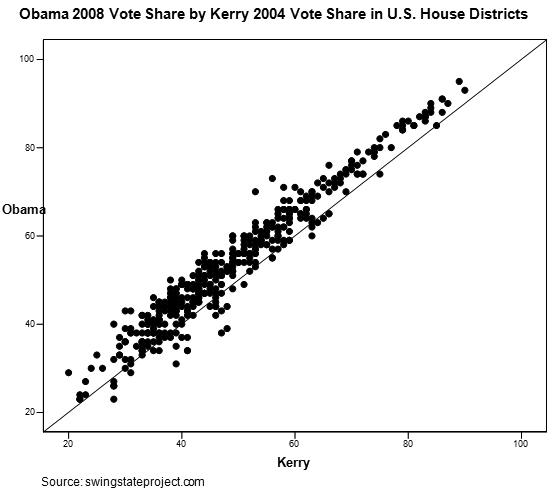How good was Barack Obama’s campaign?
I’ve blogged before about some of the myths around Barack Obama’s campaign for the US Presidency, such as the exaggerated tales of seas of small donors. Now it’s time to look at how the votes played out across the country and see what it tells us.
The US Presidential election is (with some minor exceptions) a first past the post election run across each state, with the winner scooping all the spoils. It doesn’t matter whether you win New York state by 1% or 99%; either way the result counts the same in the tally towards winning the Presidency. Therefore, when it comes to targeting campaign activities, there is a strong incentive to ignore states that are likely to be either landslide victories or defeats and instead pour efforts into the marginal areas. These ‘swing states’ in the US political parlance therefore have much the same place in campaign calculations as marginal constituencies have in the UK.
Traditionally, that targeting has primarily involved deciding where to run TV adverts, where to direct direct mail and where to send your campaign’s big names for visits. Plot Obama and McCain’s visits for 2008, for example, and you see a huge cluster in the key swing states.
The broad story of the Obama campaign is that it was well run, highly successful and used the internet in particular to mobilise large amounts of grassroots campaigning. Up against a McCain campaign that had far less money and is seen as having been much weaker, you might therefore have expected to see a fair amount of variation in the swing to Obama between different parts of the country. A good campaign, targeting its efforts well, would garner extra support in key swing areas.
The evidence, however, suggests otherwise. The Swing State Project website has compared the votes share won by Obama in 2008 against that won by Kerry in 2004 on a House district by House district basis.

As you can see from the graph, there is a striking uniformity in the change in votes. In nearly every district Obama polled more votes, and the increase was pretty uniform. There are a few outliers, which isn’t a surprise given the changing demographics of the US – very dramatic in some areas – and that the candidate teams this time came from different states from last time. Overall though the picture is one of consistency, not variation – and there isn’t any sign of a clutch of districts that clearly show an effective campaign garnering extra votes in the key swing areas.
So how to explain this?
One possibility is that the McCain campaign was better than it has been given credit for and whilst Obama’s campaign did effectively target areas, this was cancelled out by a McCain effort targeting those areas too.
A second possibility is that the targeted efforts of the Obama campaign just weren’t that good after all. We know that the much hyped talk of driving up turnout turned out to be largely a myth, so perhaps there’s a myth here too?
The third possibility is that Obama’s campaign was so successful that it ending up making its targeting redundant. This slightly perverse outcome is what happened to Labour’s 1997 general election campaign. That campaign put large amounts of effort into a range of key marginal seats, yet the swing to Labour in them was little different from that overall.
The reason? Labour’s supporters were so fired up across the country, and there was such strong word of mouth, that this swamped the targeting efforts. So perhaps the explanation is that Obama was a fantastic candidate, pulling in so much support from blanket media coverage and generating enthusiasm from people all over the place, that it swamped the efforts to target vote winning at particular areas.
The jury is still out on which of these, or what combination of them, is the explanation. But it’s certainly the case that the prima facie evidence is that the Obama campaign didn’t manage to target successfully its efforts at getting votes where they really mattered.
So the next time you hear breathless media coverage about the campaign’s targeted phone voter ID work, or micro-targeting of direct mail, or 101 other techniques, apply some pinches of salt before consuming.
Leave a Reply